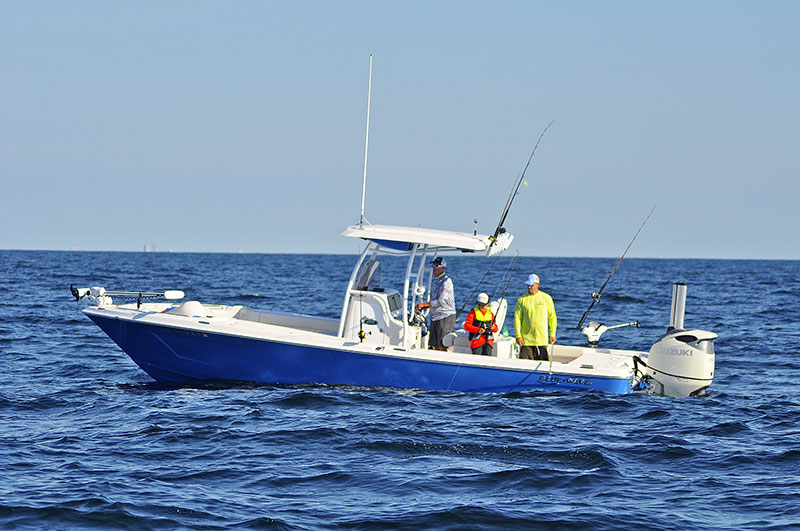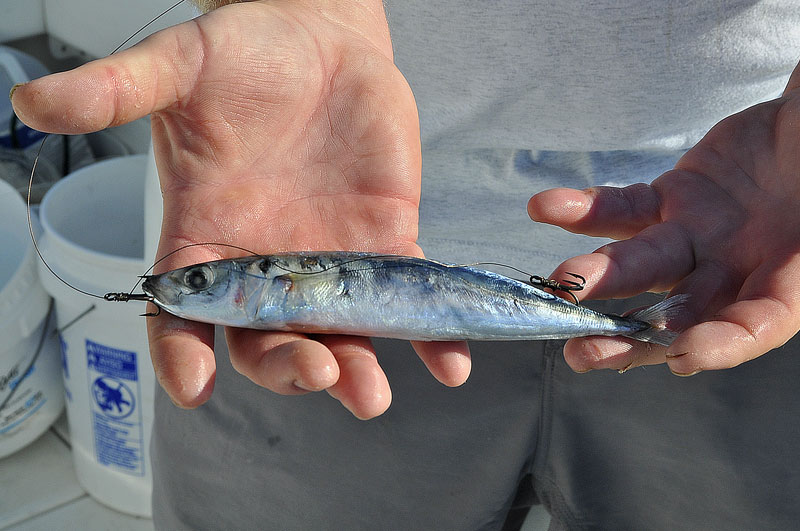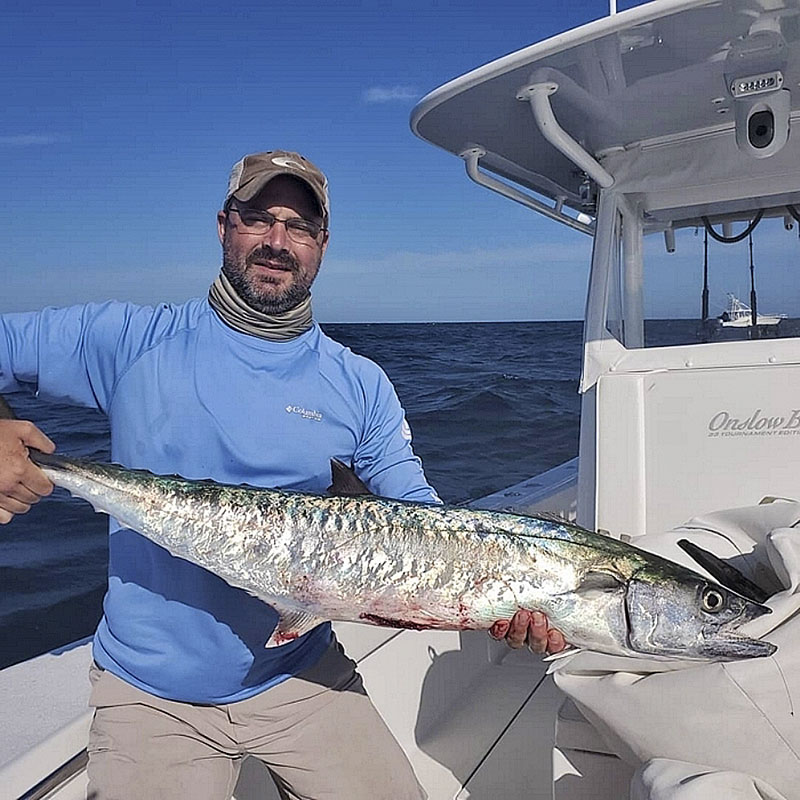
Get there early and with the right bait
According to this North Carolina charter captain, you can catch your share of king mackerel as summer really digs in.
The sonar screen showed a jagged bottom 85 feet beneath the hull of Kevin Sneed’s boat. Occasionally, spikes arose between smaller, sawtooth-like protrusions. The screen told a story to Sneed, a veteran saltwater guide from Holden Beach, N.C., who held the wheel.
“This is where we want to be,” said Sneed, who runs Rigged & Ready Fishing Charters.
Sneed had carried Aubrey Linville, a commercial real-estate salesman from Winston-Salem, and his 14-year-old son, Grayson, to one of his favorite offshore king mackerel haunts. With a north wind that calmed the ocean that morning, he’d zipped along and reached the spot less than an hour after leaving Lockwood Folly Inlet.
“One of the advantages of having a fast boat is you can get where you want in a hurry,” said Sneed,
He had two reasons for haste:
• To reach the spot as quickly as possible so his anglers would have first shot at enticing a big summer king mackerel.
• Hot-weather king mackerel bites are notoriously fickle, turning on and off unpredictably. It’s best to have lines in the water when kings decide to eat.
“By August, king mackerel seem to leave most shallow, inshore waters,” Sneed said. “You can catch them at wrecks, ledges and good livebottoms from 15 to 20 miles out. But they seem to like water around 75 degrees. A lot of times it’s 80 degrees close to land. Not many kings get caught off the end of piers in July and August.
“That’s not to say it doesn’t happen. But the best early months for inshore king mackerel bites are late April, May and June. It slows down in summer, then picks up in late September through November when waters start to cool.”
Sneed said the best bite and biggest king mackerel are during November and December.
But determined efforts will yield king mackerel this time of year
“During August, I actually don’t do much fishing for big kings, because I get caught up in the (nearshore) charter aspect,” he said. “We’re busy running half-day trips 10 to 15 miles offshore. That’s not to say we don’t catch kings — we catch a lot of them. But they’re usually smaller. That’s okay. We try to release big ones in summer because they’re not as good to eat as the 8- and 10-pounders. But if someone wants to go specifically for large kings, we’ll try it.”

Trolled slowly, live menhaden, aka pogies, are the universal king mackerel baits for anglers. But other baits also work.
“I’ll throw a cast net to fill the baitwell, if I can find pogies,” Sneed said. “But I don’t like to waste a lot of time searching for them, because anglers are paying to fish. Summer kings eat frozen cigar minnows just as well as pogies.”
If Sneed is fishing in a tournament during summer, he heads for livebottoms, ledges or wrecks in 85 to 100 feet of water south of Frying Pan Tower, some 44 miles from Lockwood Folly Inlet. Those spots are part of Frying Pan Shoals, which stretches dozens of miles southwest from the mouth of the Cape Fear River.
Find beeliners, and you’ll find kings
“I like to fish those livebottoms, especially near schools of beeliners (vermilion snappers),” he said. “In summer, if you find beeliners, kings will be near them.”
Beeliner schools show up as large red blobs on his screen, he said.
“If I see a school, I’ll cast a 1/0 live-bait hook with a little piece of Boston mackerel,” Sneed said. “Beeliners can be from 12 inches long and a half-pound to 2 pounds. King mackerel love them. If I catch several, I often put them on my trolling rods.”
In the absence of beeliners, Sneed prefers big menhaden, threadfin herring (aka greenies), bluefish or cigar minnows, live or frozen.
His trolling spread includes four rods, two at the corners of the stern and a third in a T-top holder, to pull surface baits. The fourth bait is in deeper water, clipped to a downrigger ball.
“If I check the scope and see kings, I lower the ball to their depth,” Sneed said. “Before I see kings on the screen, I put the downrigger line 20 feet deep and adjust from there. If I don’t get any action, I’ll lower it to 30 feet, then 40, 50 or 60 feet. Sometimes, all the bites come on downriggers, but sometimes they come on surface baits. You never can tell.”
Livebottoms with ledges are top notch spots
His downrigger fits into a rod-holder at his boat’s right stern corner. “All you need is a plug-in (gunwale) socket for power,” Sneed said.
He may cruise above structure 100 feet below his boat’s keel. But baitfish swim above structures from the bottom to the surface.

“Best livebottoms have ledges, which may have only 4 or 5 feet of change or as much as 10 feet,” Sneed said. “Ledges give baitfish somewhere to hide from predator fish. Beeliner schools and cigar minnows also hang out above ledges and livebottom or even a big rock.”
Sneed moves the boat forward at a crawl.
“Troll just enough to keep your lines tight,” Sneed said. “You don’t want to drag your baits; you want them to swim naturally.”
Once a king attacks, the rod screams as the fish peels line off a reel’s loosely set drag.
Sneed uses 7-foot Star handcrafted live-bait rods with Shimano Torium 30HG reels spooled with 20-pound Momoi Diamond monofilament tied to an 18-inch leader of 15- to 30-pound line. His terminal tackle includes a Spro swivel and 18 to 24 inches of 40-pound Seven Strand wire and two No. 6 black VMC treble hooks separated by a 6-inch section of wire.
Proper rigging is key
“The wire keeps a king’s teeth from slicing through leader,” Sneed said.
If he’s trolling live bait, he hooks one treble horizontally through its nostrils to allow it to swim naturally. He barely attaches a second treble through the skin near the bait’s dorsal fin.
If he’s pulling a frozen cigar minnow, he hooks the front treble vertically from under the jaw and out between the nostrils. The other treble goes just beneath the skin near its tail.

Evidence of fishing prowess
Kevin Sneed’s king-mackerel tackle and techniques were not pulled out of thin air, but earned during 20 years of saltwater fishing.
Not only that, he’s got visible proof of his fishing prowess in tournaments. Hanging on the wall behind the counter of his business, Rigged & Ready Fishing Center in Supply, N.C., is an enlargement of his $127,755 check for winning the 2018 Kingfish Cup in November 2018. It was the largest king mackerel tournament winner’s check on record nationally.
“We had a great run from 2018 to early 2019,” Sneed said. “We also won the Jolly Mon KMT ($5,600), earned $30,000 at the East Coast Got ‘Em On, my wife Kim was first-place Lady Angler at the Rumble in the Jungle ($900), and in May 2019 ,we won $20,345 for the Cape Lookout Shootout.”
That’s a grand total of $184,600.
“Kim was a big help, along with friends who fished with us,” Sneed said. “King mackerel tournament fishing is not a one-man show, but a team effort.”
Their earnings allowed them to expand their bait-and-tackle store and purchase a boat.




Awesome story! Thanks